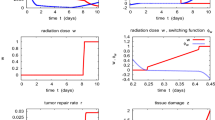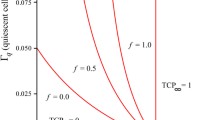Abstract
This paper deals with the optimal control of a mathematical model of glioma progression incorporating the basic facts of the evolution of primary brain tumors. We will consider a model of the simplest possible kind, based on the Fischer-Kolmogorov equations, using ideas from Pérez-García (Mathematical models for the radiotherapy of gliomas (preprint), 2016). The control is the 2n-tuple \((t_1, \ldots , t_n; d_1, \ldots , d_n)\), where \(d_i\) is the i-th applied radiotherapy dose and \(t_i\) is the i-th administration for \(1 \le i \le n\). We search for controls that maximize the survival time, that is, the time at which the tumor mass reaches a critical value \(M_{*}\), over the class of admissible radiation times and doses. We present theoretical and numerical results that justify the relevance of the model and the existence of potential medical applications.







Similar content being viewed by others
References
Bekelman JE et al (2014) Uptake and costs of hypofractionated vs conventional whole breast irradiation after breast conserving surgery in the United States, 2008–2013. J Am Med Assoc 312(23):2542–2550
Bellomo N, Chaplain M, De Angelis E (eds) (2008) Selected topics in cancer modeling. Genesis, evolution, immune competition, and therapy, Modeling and Simulation in Science, Engineering and Technology. Birkhäuser Boston, Inc., Boston
Belmonte-Beitia J, Calvo GF, Pérez-García VM (2014) Effective particle methods for Fisher-Kolmogorov equations: theory and applications to brain tumor dynamics. Commun Nonlinear Sci Numer Simul 19(9):3267–3283. arXiv:1401.2465 [q-bio.QM]
Byrd RH, Gilbert JC, Nocedal J (2000) A trust region method based on interior point techniques for nonlinear programming. Math Program 89(1):149–185
Byrd RH, Hribar ME, Nocedal J (1999) An interior point algorithm for large-scale nonlinear programming. SIAM J Optim 9(4):877–900
Evans LC (2010) Partial differential equations, 2nd edn, Graduate Studies in Mathematics, vol 19. American Mathematical Society, Providence
Fernández-Cara E, Camacho G (2011) Optimal control of some simplified models of tumour growth. Int J Control 84:540–550
Fernández-Cara E, Prouvée L (2016) Optimal control of mathematical models for the radiotherapy of gliomas: a two-equation system (preprint)
Fletcher R (1987) Practical methods of optimization. Wiley, New York
Friedman A (1964) Partial differential equations of parabolic type. Prentice-Hall Inc, Englewood Cliffs
Galochkina T, Bratus A, Pérez-García VM (2015) Optimal radiation fractionation for low-grade gliomas: insights from a mathematical model, Math Biosci 267:1–9
Ladyzhenskaya OA, Solonnikov VA, Uraltzeva NN (1968) Linear and quasilinear equations of parabolic type, Translation of Mathematical Monographs, vol 23. Providence, Rhode Island
Martínez-González A, Calvo GF, Pérez-Romansanta LA, Pérez-García VM (2012) Hypoxic cell waves around necrotic cores in gliobastoma: a biomathematical model and its therapeutic implications. Bull Math Biol 74(12):2875–2896
Murray JD (2007) Mathematical biology: I. An introduction. Springer, New York
Nocedal J, Wright SJ (2006) Numerical optimization, Springer Series in Operations Research, 2nd edn. Springer, New York
Pallud J et al (2012) Quantitative morphological MRI follow-up of low-grade glioma: a plead for systematic measurement of growth rates. Neurosurgery 71(3):729–740
Pardalos PM, Romeijn HE (eds) (2009) Handbook of optimization in medicine, Springer Optimization and Its Applications, vol 26. Springer, New York
Pardo R, Martínez-González A, Pérez-García VM (2016) Nonlinear ghost waves accelerate the progression of high-grade brain tumors. Commun Nonlinear Sci Numer Simul 39 (2016), 360–380
Pérez-García VM (2016) Mathematical models for the radiotherapy of gliomas (preprint)
Pérez-García VM, Bogdanska M, Martínez-González A, Belmonte-Beitia J, Schucht PL, Pérez-Romansanta LA (2015) Delay effects in the response of low grade gliomas to radiotherapy: a mathematical model and its therapeutical implications. Math Med Biol 32(3):307–329
Pérez-García VM et al (2011) Bright solitary waves in malignant gliomas. Phys Rev E 84:021921
Pérez-García VM, Pérez-Romasata LA (2015) Extreme protraction for low grade gliomas: theoretical proof of concept of a novel therapeutical strategy. arXiv:1407.2228 [q-bio.QM]
Pérez-Romasanta LA et al (2013) Mathematical model predicts response to radio-therapy of grade II gliomas. Rep Pract Oncol Radiother 18:S63
Pouratian N, Schiff D (2010) Management of low-grade glioma. Curr Neurol Neurosci Rep 10(3):224–231
Powell MJD (1978a) A fast algorithm for nonlinearly constrained optimization calculations. In: Watson GA (ed) Numerical Analysis, Lecture Notes in Mathematics, vol 630. Springer, New York
Powell MJD (1978b) The convergence of variable metric methods for nonlinearly constrained optimization calculations. In: Mangasarian OL, Meyer RR, Robinson SM (eds) Nonlinear Programming, vol 3. Academic Press, USA
Shampine LF, Reichelt MW (1997) The MATLAB ODE suite. SIAM J Sci Comput 18:1–22
Shampine LF, Reichelt MW, Kierzenka JA (1999) Solving index-1 DAEs in MATLAB and Simulink. SIAM Rev 41:538–552
Skeel RD, Berzins M (1990) A method for the spatial discretization of parabolic equations in one space variable. SIAM J Sci Stat Comput 11:1–32
Swan GW (1981) Optimization of human cancer radiotherapy, vol 42, Lecture Notes in Biomathematics. Springer, Berlin, New York
Unkelbach J et al (2013) Radiotherapy planning for glioblastoma based on a tumor growth model: implications for spatial dose redistribution. Physics in Medicine and Biology. IOP Publishing, Bristol
Van der Kogel A, Joiner M (2009) Basic clinical radiobiology. Oxford University Press, Oxford
Waltz RA et al (2006) An interior algorithm for nonlinear optimization that combines line search and trust region steps. Math Program 107(3):391–408
Acknowledgments
The authors are indebted to the anonymous referees for their very important comments and suggestions. They have led to substantial improvements of the paper. In particular, we thank Referee 2 for several crucial comments concerning in particular the relevance and optimality in practice of the constant-dose strategy.
Author information
Authors and Affiliations
Corresponding author
Additional information
Communicated by Dr. Luz de Teresa.
Partially supported by Grant MTM2013-41286-P, MINECO, Spain. Partially supported by CAPES Foundation, BEX 7446/13-6, Ministry of Education of Brazil, Brasília DF 70040-020, Brazil.
Rights and permissions
About this article
Cite this article
Fernández-Cara, E., Prouvée, L. Optimal control of mathematical models for the radiotherapy of gliomas: the scalar case. Comp. Appl. Math. 37, 745–762 (2018). https://doi.org/10.1007/s40314-016-0366-0
Received:
Revised:
Accepted:
Published:
Issue Date:
DOI: https://doi.org/10.1007/s40314-016-0366-0




